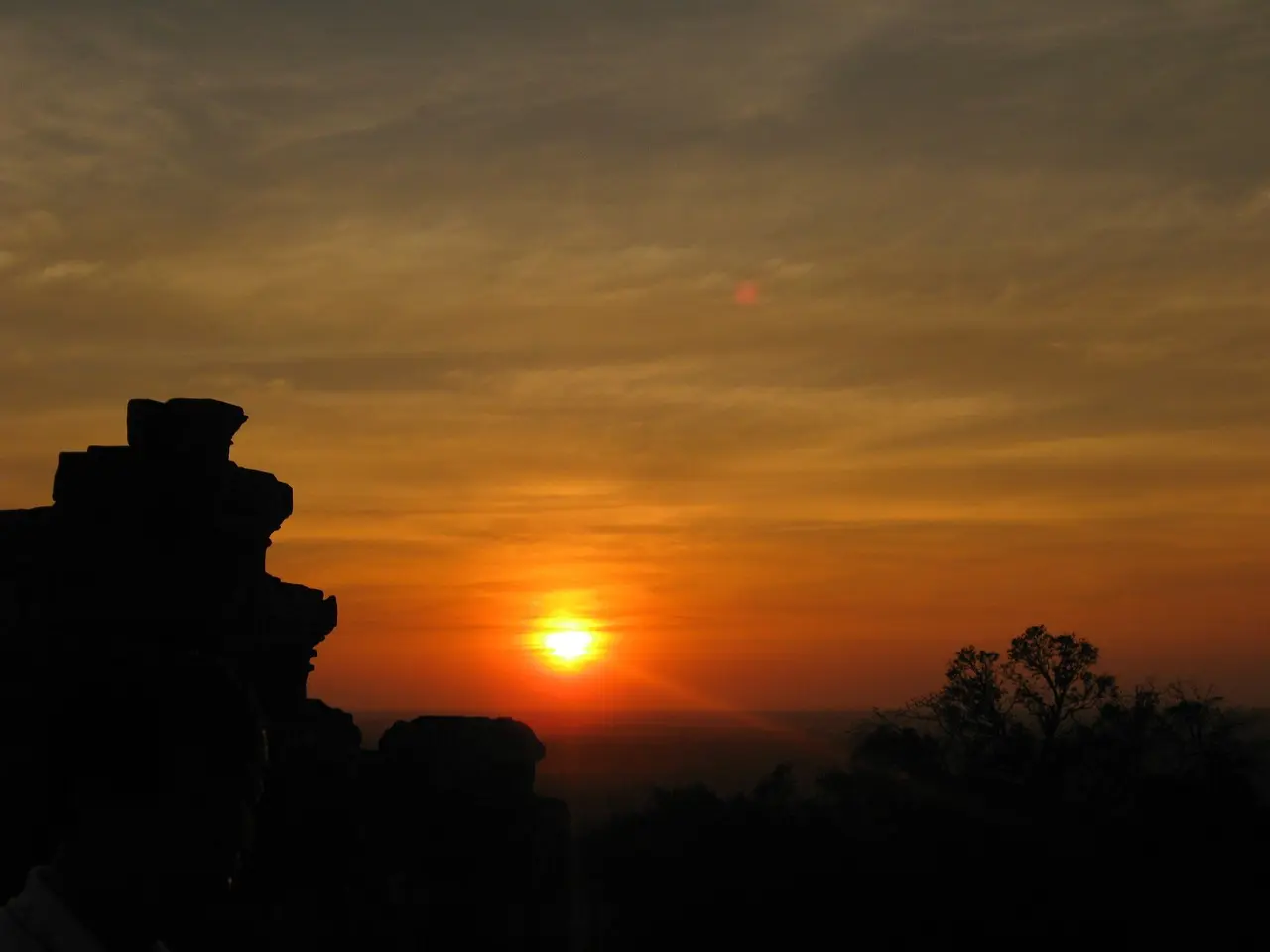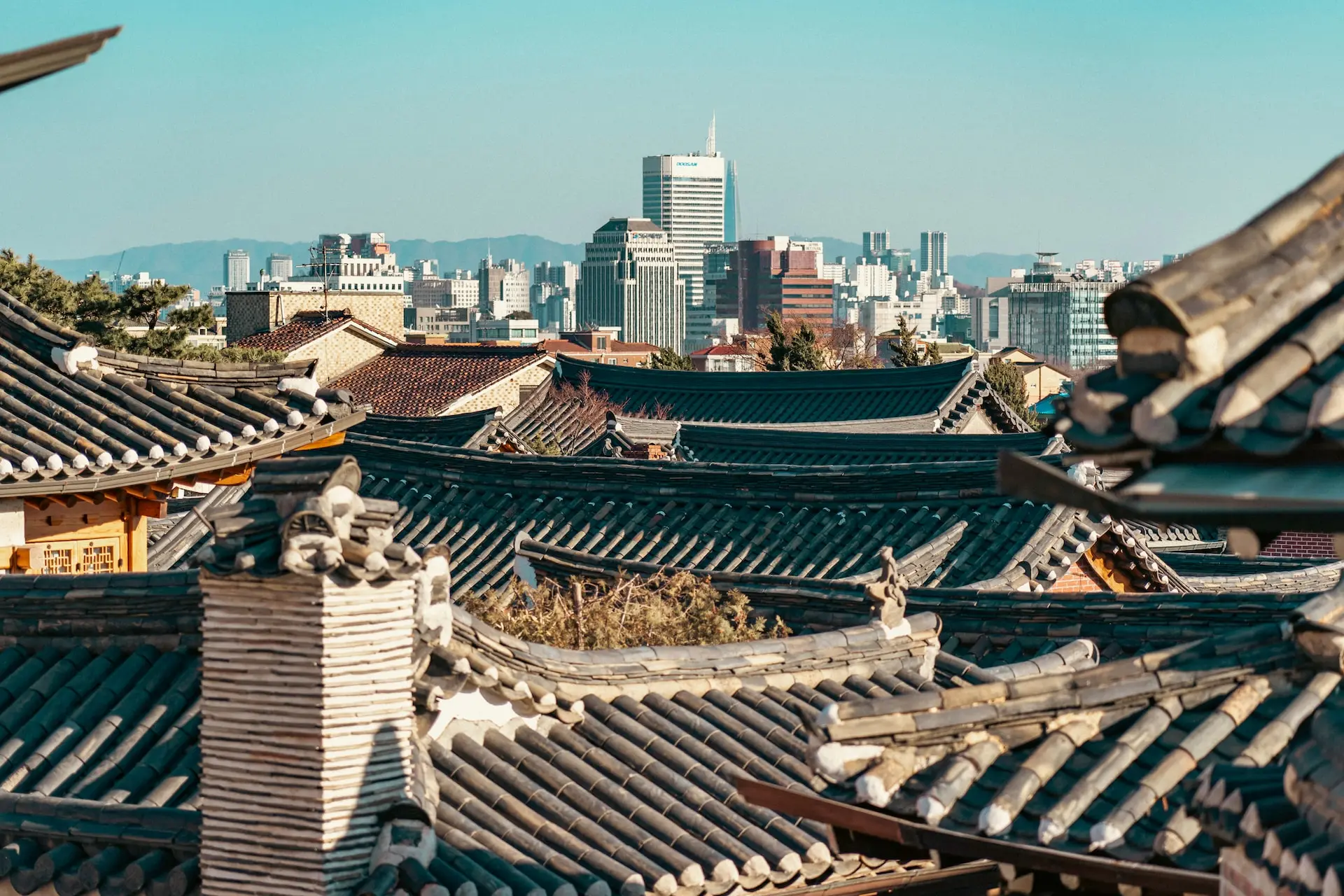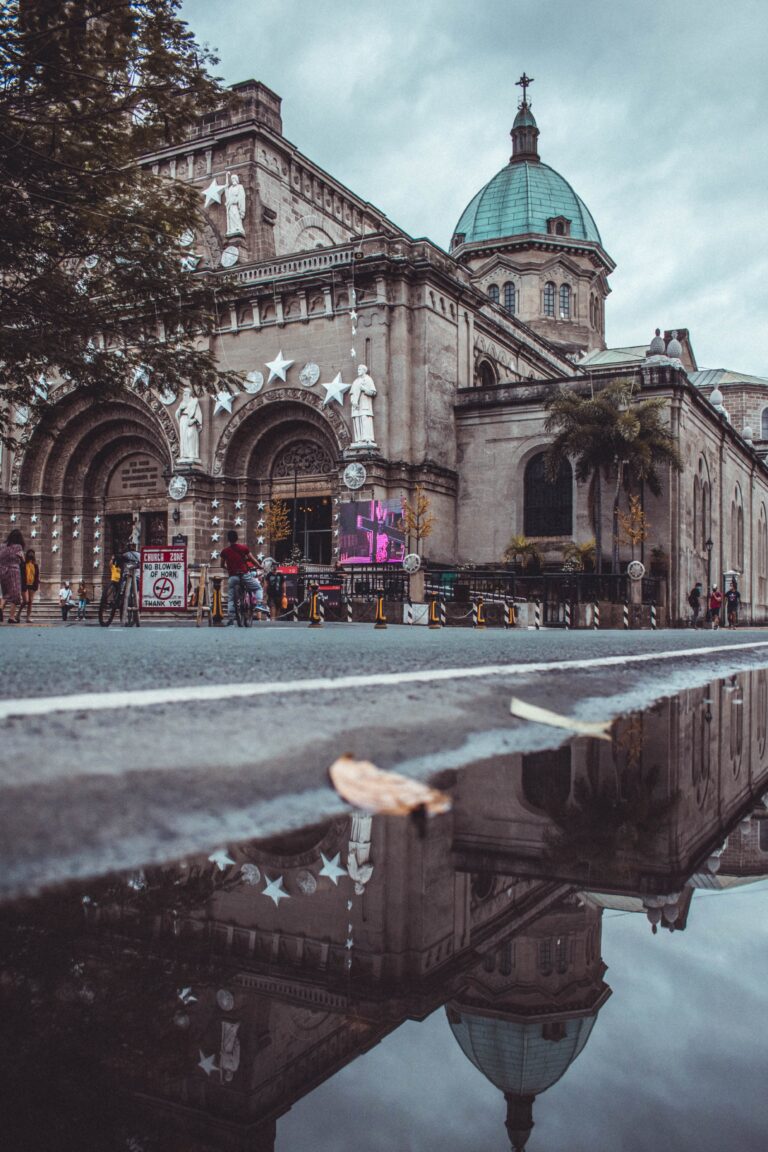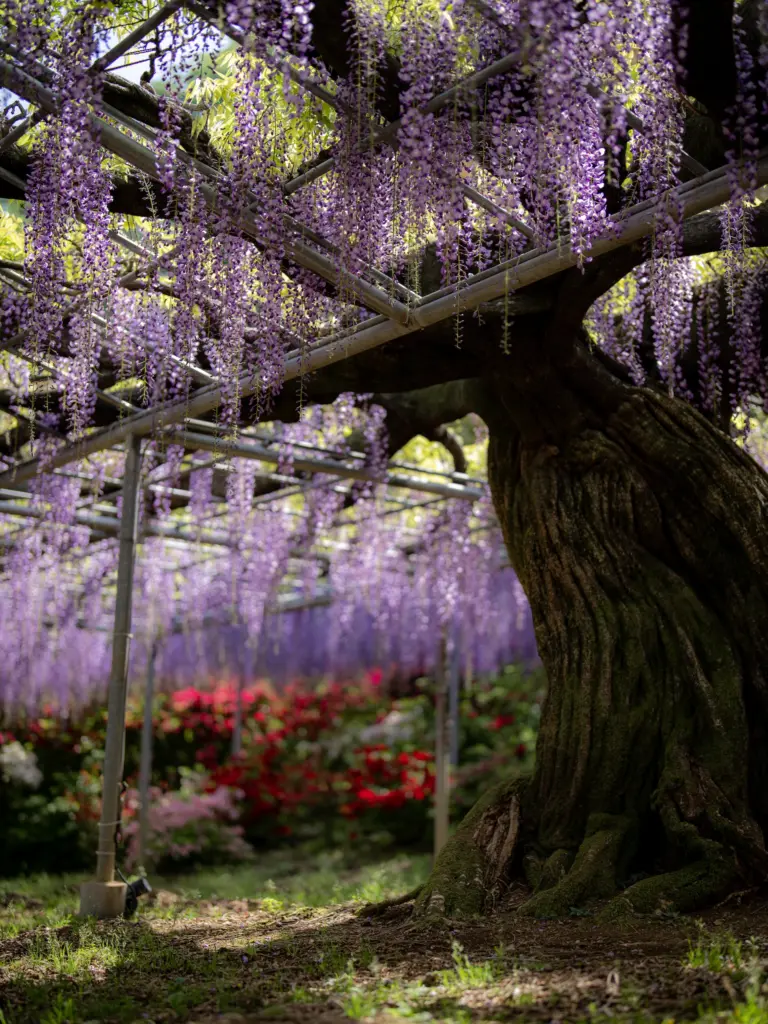When it comes to understanding religions, one often hears the terms “monotheistic” and “polytheistic”. But when it comes to Hinduism, the question arises: Is it monotheistic or polytheistic?
This question isn’t as straightforward as it might seem, because Hinduism’s view of the divine is rather nuanced. The faith doesn’t fit neatly into these categories, and the answer to the question varies, depending a lot on one’s perspective and interpretation.
However; this blog post hopes to provide you with all the information needed to understand whether Hinduism is monotheistic or polytheistic. Let’s start!
Table of Contents
ToggleDefining Monotheism & Polytheism
- Monotheism refers to the belief in a single, all-powerful God who is the creator and ruler of the universe. Monotheistic religions include the classic Abrahamic religions: Christianity, Islam, and Judaism.
- Polytheism, on the other hand, is the belief in many gods. Ancient Greek and Norse religions, for example, had many gods representing various aspects of life and nature.

Hinduism Overview
Hinduism is one of the world’s oldest religions, originating in the Indian subcontinent around 1500 BCE. Unlike many other religions, it does not have a single founder or central religious authority. Instead, it’s a diverse faith with a wide range of beliefs, practices, and traditions.
Central to Hinduism is the concept of Dharma, which guides moral and ethical living. Other key aspects include Karma, the law of cause and effect; Moksha, the liberation from the cycle of birth and death; and Yoga, a set of practices to attain spiritual growth. There’s also the concept of Chakras which are the energy centers of the body.
If you want to learn more about Hinduism’s beliefs and traditions, you can jump on to my article on it here.
Meet the Deities of Hinduism
Hinduism encompasses a wide array of deities, each of whom symbolizes different aspects, characteristics, or manifestations of the divine.
Some sources say that there are only 33 gods while others say the numbers can range up to 330 million!
While they are numerous, we need to understand that these deities are not viewed as separate gods in competition with each other, but rather as different manifestations of the same ultimate reality, Brahman.
Here are some of the central figures and their roles:
1. Brahma - The Creator
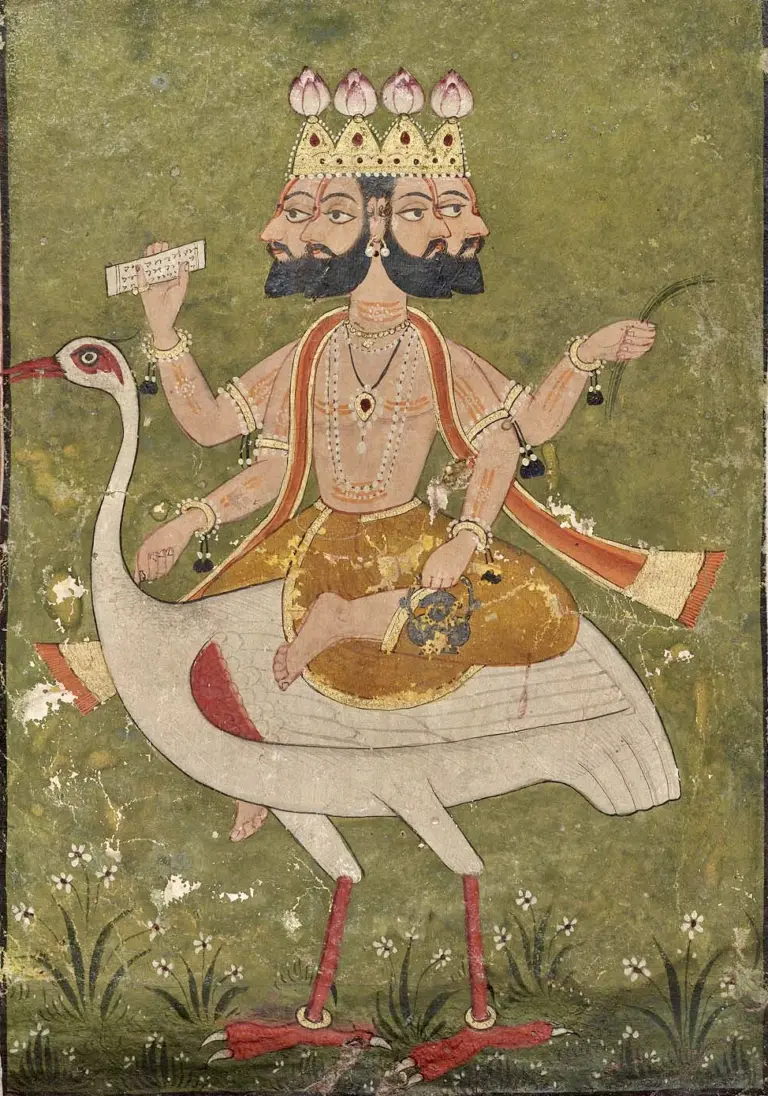
Animal Vehicle: Hamsa (Swan)
Symbols:
- The four heads also represent the four Vedas, the oldest scriptures of Hinduism, which Brahma is said to have created.
- He is often illustrated with four arms, holding a water-pot (kamandalu), a manuscript (Vedas), a sacrificial implement (sruva), and a rosary (mala).
Brahma is recognized as the god of creation and is one of the three major gods in Hinduism, known collectively as the Trimurti (Trinity). Not to be confused with “Brahman” as that’s a separate discussion further down below.
Brahma is traditionally depicted with four heads, each facing a different cardinal direction, symbolizing his omnipresence and omniscience.
Despite his status as the creator god, Brahma is not widely worshipped in Hinduism. This is often attributed to a curse given by the powerful sage Bhrigu, who was angered by Brahma’s arrogance, proclaiming that Brahma would not be worshipped by the people on earth. As a result, there are very few temples dedicated to Brahma, with the Brahma Temple at Pushkar in Rajasthan, India, being one of the few exceptions.
Brahma’s role in Hindu cosmology reflects a fundamental belief of Hinduism: the cyclical nature of the universe. According to Hindu cosmology, Brahma creates the universe, Vishnu preserves it, and Shiva ultimately destroys it, marking the end of one cosmic cycle and the beginning of a new one. This eternal cycle of creation, preservation, and destruction mirrors the cyclic nature of life and death.
2. Vishnu - The Preserver
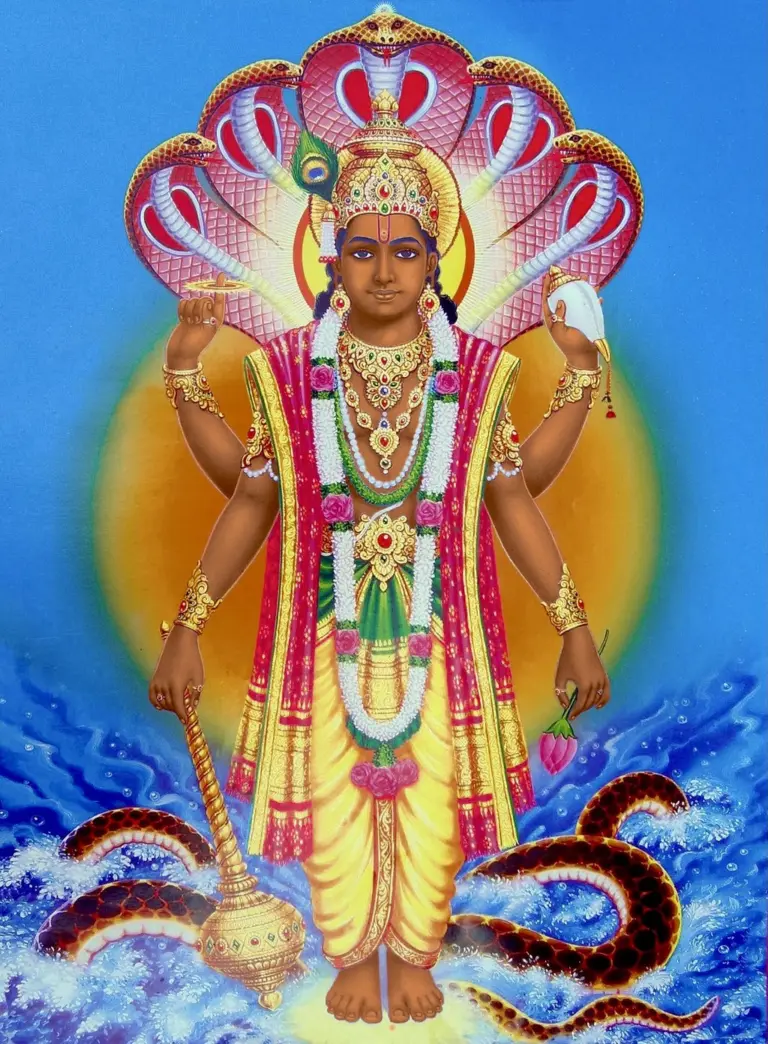
Animal Vehicle: Garuda and Shesha (Divine Eagle and Serpent)
Symbols:
- Vishnu is often depicted with four arms, each holding a different symbol: a conch shell (shankha) symbolizing the primordial sound, a discus (chakra) symbolizing the mind, a lotus flower (padma) representing liberation, and a mace (gada) signifying power.
Vishnu, also known as Narayana, is revered as the protector and preserver of the universe. As part of the Trimurti, he is seen as the force that maintains balance and harmony, stepping in to intervene when the equilibrium of good and evil in the world is threatened.
He is usually shown in a calm and serene pose, often lying on the cosmic serpent Shesha, with his consort, the goddess Lakshmi, at his feet. His skin is typically depicted as being dark blue, symbolizing the infinite and immeasurable vastness of the universe.
A unique aspect of Vishnu is his ten avatars, collectively known as “Dashavatara.” Each avatar represents a divine intervention made by Vishnu to restore Dharma whenever it was under threat. Some of the most popular of these avatars include Rama, the ideal king from the epic Ramayana; Krishna, the divine cowherd from the Mahabharata and the speaker of the Bhagavad Gita.
So, while Vishnu is one deity, his various avatars and forms, each with their unique stories and followers, could contribute to the perception of Hinduism as polytheistic, but let’s proceed further before making any conclusions.
3. Shiva - The Destroyer
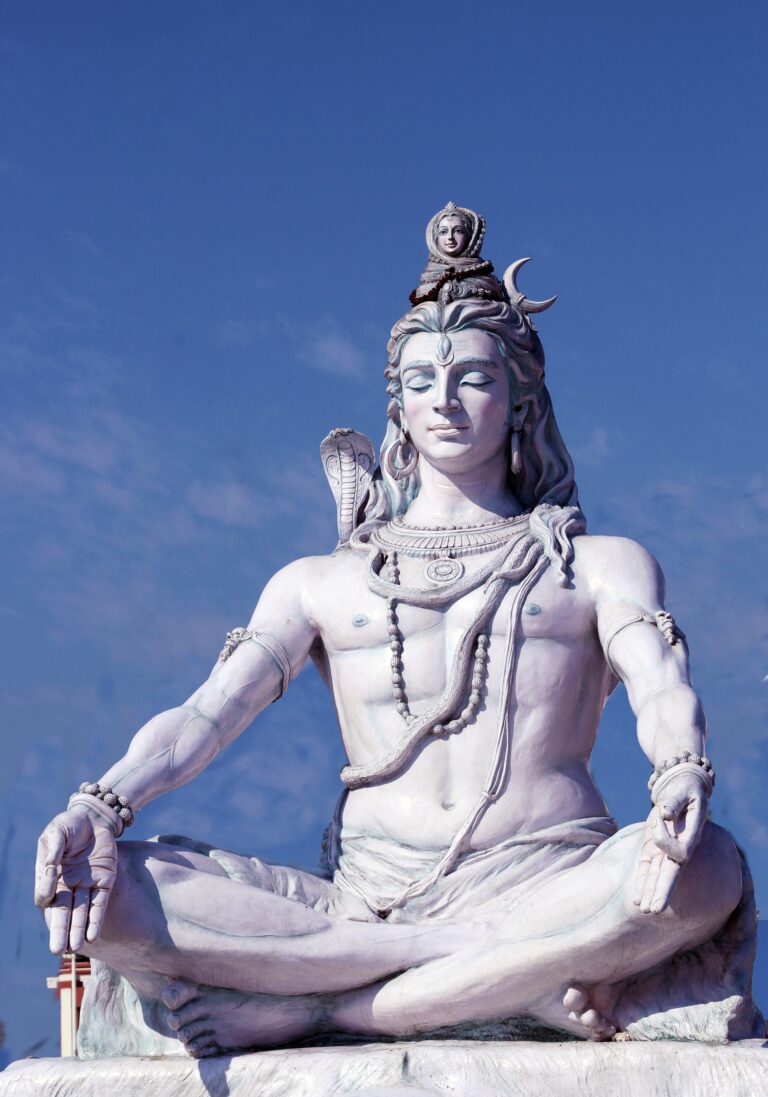
Animal Vehicle: Nandi (Bull)
Symbols:
- He is typically depicted with a third eye on his forehead, which represents wisdom and is said to have the power to destroy everything it sees when opened.
- He also carries the trishul (trident) symbolizing the three gunas (fundamental forces): sattva (goodnes), rajas (passion), and tamas (darkness)
- Around his neck, Shiva wears Vasuki (king of the serpents) as a reminder of the cyclical nature of time and the impermanence of life.
- He also has the sacred river Ganges flowing from his matted hair, indicating his power of purification.
Shiva is the third god in the Hindu Trimurti. He represents destruction and transformation, but not in a negative or malevolent way. Instead, Shiva is seen as the force that paves the way for new creation after the old has been destroyed. He’s also often associated with asceticism and meditation, and is seen as the patron of yoga.
Shiva is often portrayed in a meditative pose. His mantra is the famous “Om Namah Shivaya”
Shiva’s consort is the goddess Parvati (who’s also known in other forms as Durga, Kali, and others). They have two sons: Ganesha, the elephant-headed god of wisdom and success, and Kartikeya, the god of war (whom you can find standing outside the Batu Caves in Kuala Lumpur). This divine family is a popular theme in Hindu art.
4. Saraswati - The Goddess of Wisdom

Animal Vehicle: Swan
Symbols:
-
Often depicted as a beautiful woman dressed in pure white, which symbolizes the light of knowledge
-
Same with Brahma, she holds the Vedas which embody knowledge
-
The mala which represents the power of spirituality
-
The water pot signifies the power to purify the mind
-
The veena represents the arts and her perfection thereof
Saraswati is the goddess of wisdom, knowledge, music, art, and learning. She is a part of the Tridevi (Trinity of Godesses including Lakshmi and Parvati) who assist the trinity of Brahma, Vishnu, and Shiva in the creation, maintenance, and destruction of the Universe.
Saraswati is considered to be the mother of the Vedas, the oldest scriptures in Hinduism, and is often associated with the sacred syllable “Om,” which is considered to be the sound of the universe in Hindu cosmology.
She is also revered as the divine consort of Brahma. As it goes, Brahma was inspired by the beauty of Saraswati and used her wisdom to create the universe.
Interestingly, due to religious syncretism Saraswati has also made her way to Buddhist and Shinto pantheons where she is known as Benzaiten, still holding a veena-like instrument (lute).
5. Lakshmi - The Goddess of Prosperity
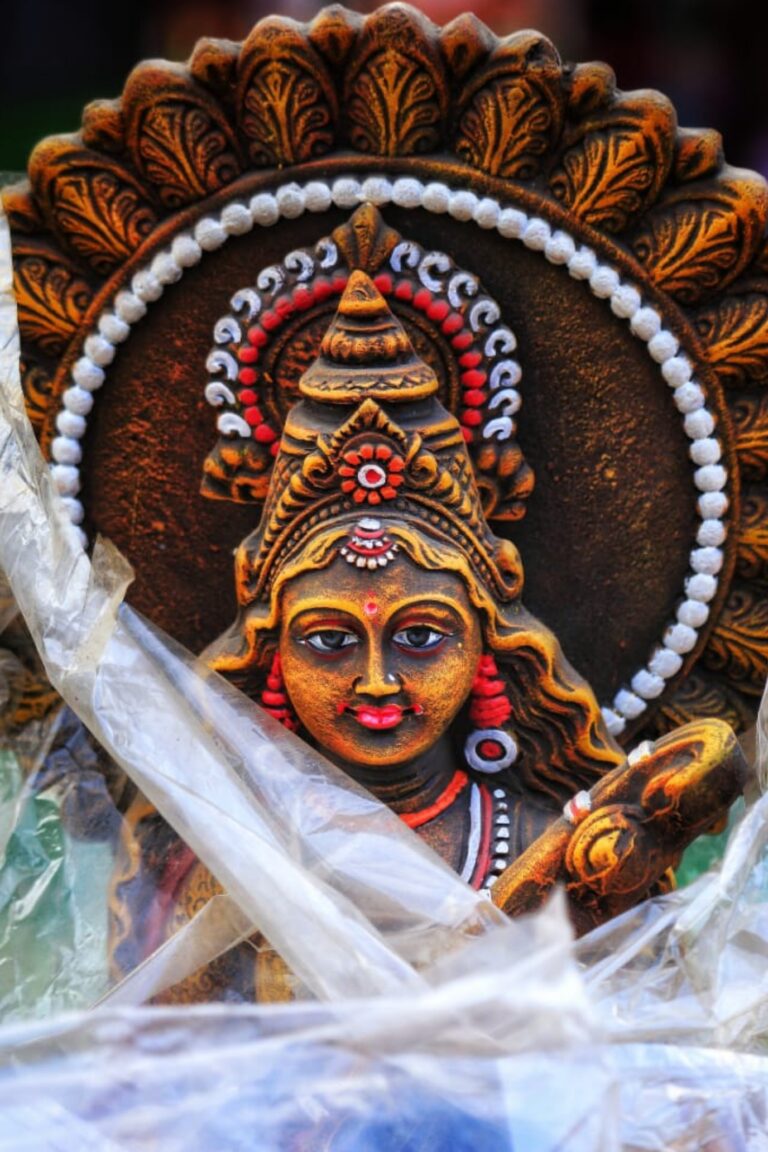
Animal Vehicle: Garuda
Symbols:
Lakshmi is often sitting on a lotus flower. The lotus represents purity.
In her four hands, she often holds lotuses of different colors, which symbolize the various aspects of the self-realization journey.
She is also frequently shown showering gold coins onto the world, which symbolizes the wealth and prosperity she bestows upon her devotees.
Her other hand is usually shown in the Abhaya Mudra, a gesture of blessing.
Lakshmi is known primarily for her associations with fortune – both material and spiritual. She also symbolizes beauty.
She is one of the most widely revered deities in Hinduism, a lot of my Hindu friends pray to her. She is also one of the main stars during the Festival of Lights (Diwali), one of the biggest and most important festivals in Hinduism.
Lakshmi is the consort of Lord Vishnu, the preserver god in the Hindu Trimurti, and she accompanies him in all of his incarnations being one of the Tridevi. In the popular story of Lord Rama (an avatar of Vishnu), for example, Lakshmi incarnates as Sita, Rama’s devoted wife.
6. Parvati - The Goddess of Fertility

Animal Vehicle: Lion and Tiger
Symbols:
-
The trident is a clear sign of her authority over all aspects of existence.
-
The lotus flower, a symbol of divine beauty and purity.
-
The conch shell in Parvati’s hand, it symbolizes the dissemination of divine truth and the cosmic vibrations that underpin all of existence.
-
The japamala in her hands symbolizes her divine powers of meditation
Parvati is a key Hindu goddess, revered as a symbol of power, love, fertility, and devotion. She is the gentle manifestation of the supreme goddess (Mahadevi), often depicted with a benign, nurturing expression. As the consort of Shiva, Parvati plays a crucial role in the ascetic god’s life by drawing him into familial affairs.
One of the many fascinating aspects of Parvati is her ability to take on various forms. She is known by different names and is the divine force behind many powerful goddesses such as Kali, the fierce warrior; Durga, the invincible.
Parvati’s origin story varies across different texts, but a common version portrays her as a reincarnation of Sati, Shiva’s first wife, who self-immolated herself at a yajna (ritualistic sacrifice) because her father disrespected Shiva.
Following Sati’s death, a distraught Shiva retreated from worldly affairs and immersed himself in deep meditation. As Parvati, Sati reincarnated with the specific goal of drawing Shiva out of his reclusion, marrying him, and bearing his child.
In addition to being a devoted wife and mother, Parvati is also depicted as an ascetic. Often, you can find images of her meditating. This mirrors her relentless determination to win Shiva’s affection, which, according to the legends, she achieved through rigorous penance.
Parvati’s relationship with Shiva embodies the ideal marital spirit, where both partners have equal roles to play. This notion contrasts with many patriarchal interpretations found in ancient texts.
7. Ganesha - The Remover of Obstacles

Animal Vehicle: Mouse
Symbols:
-
In art, Ganesha is often depicted with a large belly, representing generosity.
-
One hand usually holds a bowl of sweets, representing the rewards of a wise life. In the other hands, he often carries a lotus flower (indicating enlightenment), a hatchet (to cut away attachment), and a mudra (hand gesture) of blessing.
-
Ganesha also has a single tusk, while the other one appears broken or cut off. A common story says that Ganesha broke off his own tusk to use as a pen when writing the epic Mahabharata.
Ganesha, also known as Ganapati or Vinayaka, is one of the most well-known and loved deities in the Hindu pantheon. He’s easy to recognize with his elephant head and human body, a unique characteristic that has made his image iconic not only in India but around the world.
Ganesha is also really special to me personally as he is one of the first deities I encountered through Mose’s song Om Ganesha which really paved way for my journey into Hinduism.
If you’re interested in learning more about Ganesha’s mantra “Om Gam Ganapataye Namaha,” you can find more information here.
I was able to see Ganesha in so many countries outside India, particularly Thailand and Sri Lanka who are predominantly Theravada Buddhist countries! I’ve also seen him in Bali come to think of it.
Ganesha is the son of Shiva and Parvati, and he is known as the lord of beginnings and the remover of obstacles. Because of these roles, his image is often invoked or worshipped at the start of any new venture, be it starting a business, buying a new home, or even writing a book. Ganesha clears the path of potential difficulties and paves the way for success.
8. Rama - The Ideal Man

Symbols:
Rama’s depiction often shows him holding a bow and arrow, symbols of his warrior capabilities.
Rama is considered the seventh avatar of Lord Vishnu and plays a central role in the ancient Indian epic Ramayana. I highly recommend reading it, it’s one of my favorite stories to this day!
You can read the full story and the life lessons of Ramayana through here.
Rama is depicted as an ideal king, an embodiment of Dharma, and a hero with unswerving loyalty to truth, honor, and duty. His life story is depicted as one of perfect adherence to Dharma despite difficult circumstances.
Rama’s narrative is also one of a great love story. His wife, Sita, is considered an embodiment of the perfect wife, with unwavering loyalty to her husband. The story of their love and separation is one of the major themes of the Ramayana.
You can often find depictions of Rama accompanied by his wife, Sita, his devoted servant, Hanuman, and his loyal brother, Lakshman.
Rama’s life and teachings have had a profound influence not only in Indian culture but surpasses borders, making its way to the cultures of many other countries.
You can find the Ramayana’s influences through the Kecak dance in Bali, the Thai adaptation known as Ramakien, in the bas-reliefs of Siem Reap’s Angkor Wat and even in the traditional arts of Malaysia through the form of shadow puppetry, Wayang Kulit.
9. Krishna - The God of Love

Symbols:
Krishna is often depicted with a flute. More than just a musical tool, the flute represents a call to liberation – an enchanting melody that invites us to let go of earthly attachments and desires.
The peacock feather is another one of his symbols. As the national bird of India, the peacock represents beauty, joy, and grace – qualities often associated with Krishna himself. Moreover, the many eyes on the peacock’s feathers are said to symbolize the omnipresent nature of Krishna, seeing and understanding everything in the universe.
Krishna is considered to be the eighth avatar of Lord Vishnu. He is perhaps most famous for his role in the Indian epic, the Mahabharata, where he delivers the discourse of the Bhagavad Gita, one of the most important texts in Hindu philosophy.
Krishna is revered as a divine hero, a supreme being, and the embodiment of love and divine joy that destroys all pain and sin. He is the reason why cows are considered sacred in India, earning him the title of Gopala, meaning “protector of cows.”
One of the most well-known stories from Krishna’s early life is his playful and mischievous childhood and youth as a cowherd, stealing butter and playing the flute.
His love for Radha and the tales of their love are a significant theme in Indian art and religious thought. Radha-Krishna’s love is described as the highest form of devotion, symbolizing the soul’s intense longing and willingness for the ultimate unification with God.
The Bhagavad Gita, a 700-verse section of the Mahabharata, documents the conversation between Prince Arjuna and Krishna, who serves as his charioteer.
In this philosophical text, Krishna discusses a variety of philosophical issues and explains the paths of devotion, action, and knowledge, among other topics.
10. Hanuman - The God of Devotion

Symbols:
- He is often shown carrying a gada (mace), a symbol of his might.
- Hanuman is sometimes shown carrying a mountain. This is a reference to the Ramayana, where Hanuman carries an entire mountain bearing the Sanjivani, the life-saving herb to heal Lakshmana, Rama’s brother. This symbolizes his incredible strength and the lengths he will go for his devotion.
Hanuman, the mighty ape that aided Lord Rama in his expedition against evil forces, is one of the most beloved deities. Known for his robust physique, unwavering devotion, and boundless courage, Hanuman is a symbol of strength, selflessness, and loyalty.
Born to Anjana and the wind god Vayu, Hanuman was bestowed with supernatural abilities. His exploits in the Ramayana are legendary. Hanuman shows extreme devotion to Rama and Sita, performing extraordinary feats to assist them, without Hanuman, Rama would never have been able to reunite with Sita.
If you want to get a snapshot of Hanuman, I encourage you to read the Hanuman Chalisa which you can find here. I recommend listening to Krishna Das, he’s one of my favorite singers!
What is Brahman in Hinduism?
Now after the introduction of just a few of the deities, it’s easy to lean towards the view that Hinduism is polytheistic but to understand further, we first need to grasp the Hindu concept of Brahman.
Brahman is often described as the ultimate reality, the supreme cosmic power, or the absolute truth. It’s often considered to be beyond human comprehension and transcendent – it exists beyond time, space, and the physical realm, yet is present in everything.
It sounds like how one would describe the God from the Abrahamic religions but this still isn’t the case.
Brahman isn’t a God or a deity in the way we might traditionally think of one. It isn’t a being to be worshipped but the highest principle – formless, limitless, and eternal. Brahman is the unifying force of the universe, underlying everything, connecting all things, and giving life to all things.
Hindu deities are seen as manifestations of Brahman. This idea is where the complexity of Hinduism often comes in.
There are many gods and goddesses in Hinduism, each with their unique characteristics, stories, and functions. However, these deities are not viewed as separate from Brahman. Instead, they are expressions of Brahman.
For example, Brahma, Vishnu, and Shiva are three significant deities often associated with creation, preservation, and destruction, respectively. But these are not separate entities – they are aspects of the one ultimate reality, Brahman. Similarly, other deities like Lakshmi, Saraswati, Krishna, and Ganesha are all manifestations of Brahman, reflecting different qualities of the Supreme Reality.
So, while Hinduism may seem polytheistic on the surface, with its vast pantheon of deities, it holds at its core a monotheistic belief. All gods and goddesses are Brahman, and Brahman is in all things.
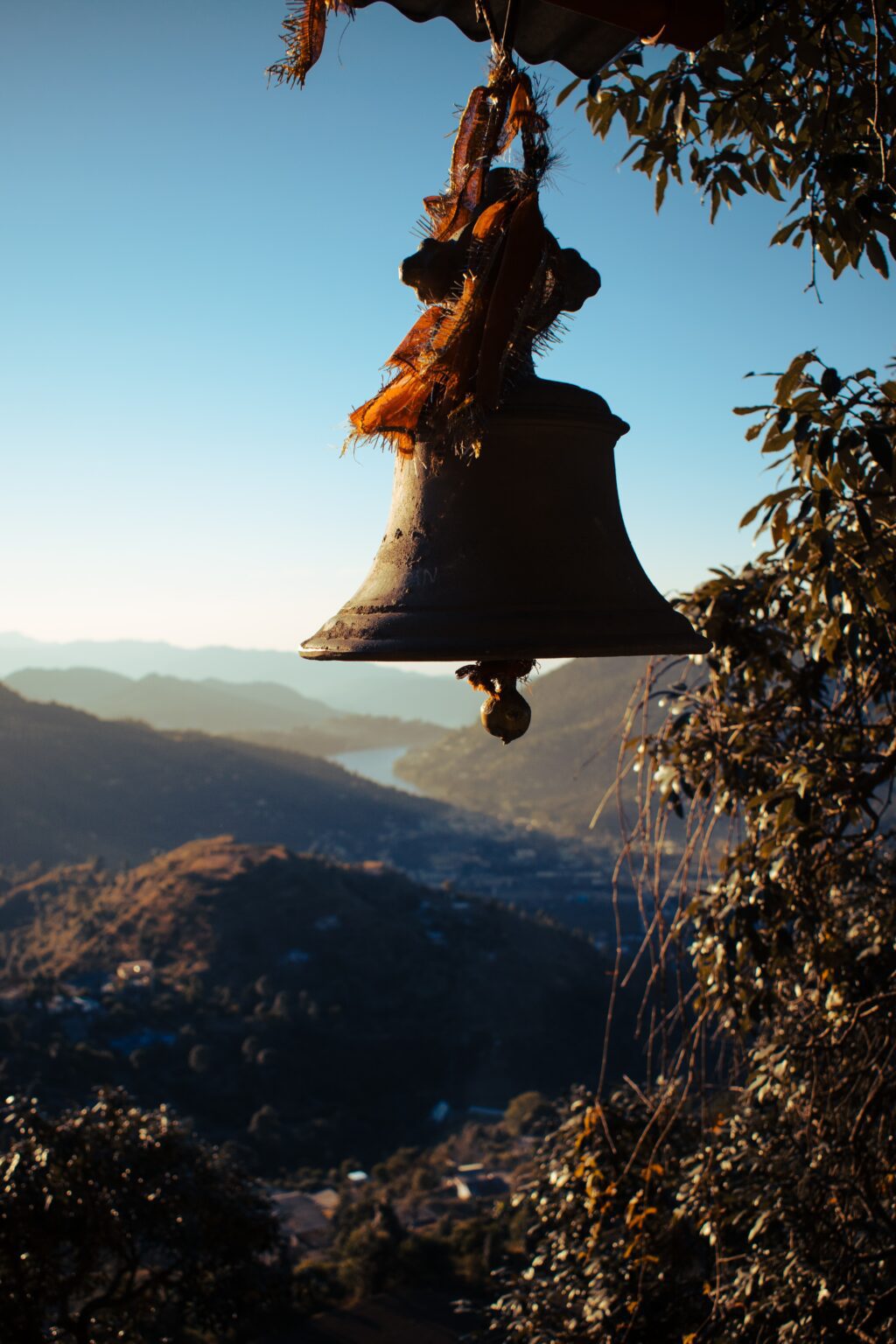
What is Ishvara in Hinduism?
Ishvara is another interesting concept in Hinduism, and it’s related to how we understand the divine and our personal relationship with it. The term Ishvara is often translated to mean a personal god.
Unlike Brahman, which is impersonal, formless, and beyond our human grasp, Ishvara is a form of the divine that we can personally connect with and understand.
So how does Ishvara fit into the grand picture of Hinduism, particularly when talking about monotheism and polytheism?
Well, Ishvara offers a way for people to connect with the divine on a personal level. Many people may find it challenging to relate to the concept of Brahman, the abstract and all-encompassing reality.
Ishvara, as a personal god, provides a form and characteristics that people can relate to, love, and worship.
For example, some people might choose to worship Ishvara in the form of Vishnu, Hanuman, or Krishna, among others. But the essence of these deities and their various forms is still Brahman, the supreme reality.
In this way, Ishvara can be seen as a bridge between monotheism and polytheism in Hinduism. It’s about the personal connection and devotion to a specific deity (which seems polytheistic), but with the understanding that this deity is a manifestation of the one supreme reality (which is monotheistic).

Interpretations According to Hindu Scriptures
- Vedas: While the Vedas contain hymns to a multitude of deities, such as Indra, Agni, Varuna, and others might seem polytheistic at first glance. The Rigveda, one of the oldest texts in the Vedas, introduces the idea of a single, formless divine reality, which is Brahman.
- Upanishads: The Upanishads which came later, explore this concept of Brahman more deeply. They teach that the multiple deities are manifestations of the same ultimate reality, Brahman. They famously say “Tat Tvam Asi” or “You are That” signifying the ultimate unity of Atman (the individual soul) and Brahman. This is a monotheistic view, is it not?
- Bhagavad Gita: One of my favorite books and another highly respected Hindu scripture, introduces the concept of Ishvara. In it, Lord Krishna talks about his divine nature and explains how all beings and deities come from him. He presents himself as a personal God, a single divine being who can be worshinated in various forms, blending monotheistic and polytheistic views.
- Puranas: The more recent texts known as Puranas are filled with stories of various deities, their adventures, their relationships, and their devotees. These texts seem to favor a more polytheistic view as they detail the lives and deeds of various gods and goddesses.
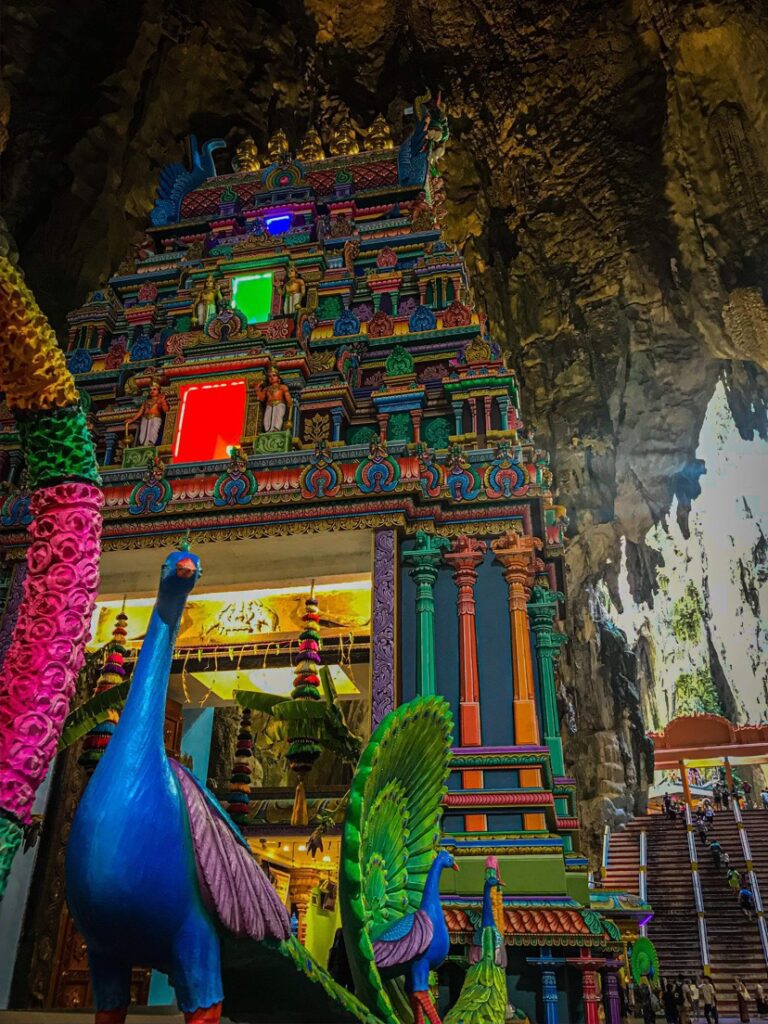
Hinduism as Henotheism and Monism
While I’ve mentioned the terms monotheism and polytheism, it’s important to introduce two other terms that come up frequently when discussing the nature of divinity in Hinduism: Henotheism and Monism.
- Henotheism is a religious system in which a single deity is worshipped, but the existence of other deities is not denied. This concept is very much present in Hinduism. For instance, a devotee of Vishnu might focus their worship on Vishnu, viewing him as the Supreme Being, while acknowledging the existence of other deities like Shiva or Ganesha. Similarly, a devotee of Shiva might see Shiva as the ultimate reality, while not denying the existence and powers of other gods and goddesses.
- Monism, on the other hand, is the belief that all things come from a single reality. In Hinduism, this idea is reflected in the concept of Brahman, the ultimate reality that is the source of everything. All gods, goddesses, humans, animals, and even the universe itself are considered manifestations of this singular reality.
These philosophical concepts add more layers to the understanding of divinity in Hinduism. They show that the religion’s approach to divinity is highly nuanced, flexible, and multifaceted.
It allows for a singular focus on one deity (henotheism), recognition of the multiplicity of deities (polytheism), affirmation of a singular impersonal ultimate reality (monism), and belief in a singular personal god (monotheism). This is really what makes Hinduism uniquely inclusive and extraordinarily diverse in its understanding of the divine.
Is Hinduism Monotheistic or Polytheistic?
So finally, we are back to the question “Is Hinduism Monotheistic or Polytheistic? A really complex question due to the vast range of philosophies within the Hindu faith. Depending on which tradition, text, or individual you refer to, you may find different answers to this question.
From one perspective, Hinduism can be viewed as monotheistic, as all the deities could be seen as manifestations of one Supreme Reality, known as Brahman. This principle can be found in the Vedantic philosophy which holds that the multitude of gods and goddesses are all facets of one, unknowable Divine Essence.
However, from another perspective, Hinduism could be seen as polytheistic, given the myriad of gods and goddesses worshipped by Hindus. Each deity is often worshipped as if they were the Supreme Deity, particularly in Bhakti practices, which emphasize devotional worship to a chosen god or goddess.
Hinduism can also be viewed as henotheistic (worshipping one god while not denying the existence of other gods) and monistic (believing all things are one). Concepts such as Ishvara, personal god, and Atman, inner self, also add more layers of complexity.
The difficulty of labeling Hinduism as strictly monotheistic or polytheistic also stems from the limitations of language and cultural understanding. The categories of “monotheism” and “polytheism” are based on western religious models, which may not entirely fit with the theological models found in Hinduism.
So while it’s human nature to categorize and label things for better understanding, trying to pin down Hinduism as either monotheistic or polytheistic oversimplifies the religion’s multifaceted nature.
Perhaps the best way to understand Hinduism is to simply appreciate its diversity and complexity, recognizing that it encompasses a wide array of beliefs spanning monotheism, polytheism, and everything in between.
It may not be the answer you are looking for but you are more than welcome to pick out what truly resonates with you with the ideas I have presented here.

